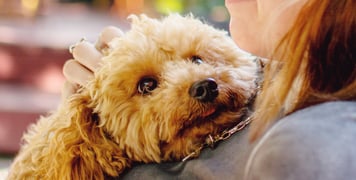Do Pugs Shed? A Complete Guide to Managing the Fur
Index:
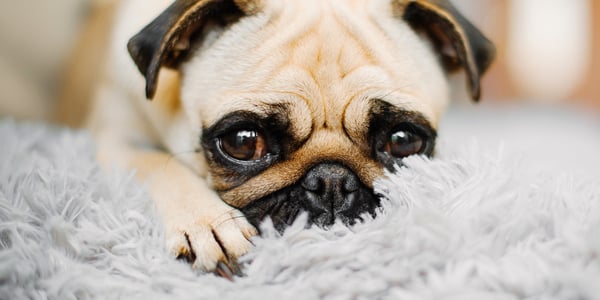


Introduction
Pugs are famed for their sweet faces, comical snorts, and big personalities. But many of us wonder whether they leave fluff on every cushion in the house.
The short answer is that Pugs do shed, and they can shed a lot. From the double coat of a fawn Pug to the glossy coat of a black Pug, there is plenty to know about controlling that floating fur in your bedroom, on your sofa, and affecting the style of your favourite jumper.
Key takeaways
Pugs often shed a lot, due to their double coat and frequent hair replacement cycle
A healthy diet, including fatty acids, supports healthy skin and helps to shed less
Groom and brush your Pug regularly with the right tools to manage build-up
Keep an eye out for excessive hair loss or skin concerns, and visit your vet for peace of mind
Using gentle shampoo and conditioning products can help reduce extra stray hairs
Quick answer: Yes, and here’s why
Pug owners sometimes feel that their sofas are growing a whole new puppy. This happens because Pugs do indeed shed heavily, thanks to their short but dense coat.
Even a Fawn or Black Pug has more to offer than meets the eye. Their hair grows and replaces itself year-round, rather than coming out in one burst like some other dog breeds.
What drives this consistent shedding? It’s partly down to genetics and partly because most dogs shed to maintain temperature regulation and healthy skin. Pugs aren’t the only small canines with a reputation for constant fur loss, but they’re definitely up there.
If you’re curious about how Pugs’ adorable personalities balance out their hairy side, you might enjoy a quick read on their breed background.
It’s a short but fun look at why these dogs are unique, both in appearance and temperament.
The science behind Pug shedding
A Pug shed cycle is tied to their double coat, which features a soft, insulating undercoat and a coarse but protective topcoat.
When one layer is busy growing, the other can be in a resting phase. This is why you see hair all year round.
Some owners of a fawn Pug may notice heavier clumps of fur in springtime, whereas a black Pug may seem to lose short hairs in a continuous stream.
Year-round vs seasonal shedding is usually more apparent if your canine spends a lot of time outdoors.
The light and temperature changes can prompt seasonal coat changes.
Indoor Pugs may still shed a lot, but often their cycles are a bit more evened out, with daily hair drops rather than one big seasonal blow.
If you’re fascinated by the broader reasons behind hair loss across breeds, we love this piece on why dogs moult. It explores the science behind shedding, no matter the dog breed.
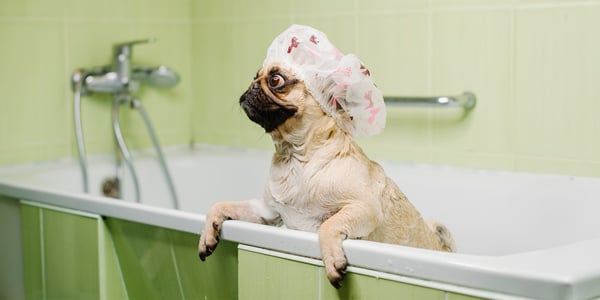


Common causes of heavy shedding in Pugs
Breed genetics play a significant role, but sometimes a surge in excess fur can be a clue you and your vet need to investigate. Here are a few possible reasons:
Seasonal coat changes: A mild winter or a warm spring can trick that coat into switching phases.
Poor nutrition: If your dog’s food lacks essential fatty acids, protein, or vitamins, their coat may suffer.
Skin irritations or allergies: Scratching and biting lead to further hair loss, and can blow up a simple shed into a bigger problem.
Hormonal or stress-related issues: Certain conditions, like an underactive thyroid, can trigger heavier shedding. Stress in dogs can also appear as bald patches or over-grooming.
For a deeper dive into the Pug’s unique textures and colours, this guide on Pug coat variations is a fun read.
Spotting the signs of excessive shedding
It’s normal if your Pug leaves a little “furry outline” of themselves wherever they sit, but watch for big changes. You know your dog best.
If they suddenly lose huge patches or have flaky skin, scabs, or lumps, don’t ignore it. That’s a sign of more severe issues.
Redness or open sores, constant itching, or hair that comes out in clumps can point to medical problems that need a vet’s evaluation.
Some lumps can be benign, but others may indicate infections or a more serious condition. If you're wondering when to book a vet appointment, it's quite straightforward: if you feel uneasy about your dog’s shedding, trust your gut and give the clinic a ring.
As a Waggel member, you have access to our convenient (and free) video vet whenever you need professional advice.
Proven ways to keep Pug shedding under control
Managing Pug hair isn’t just about your vacuum’s ability. It’s a multi-step approach that depends on grooming, diet, and pest control. Below are some well-tested approaches that many Pug owners use to help reduce hair loss.
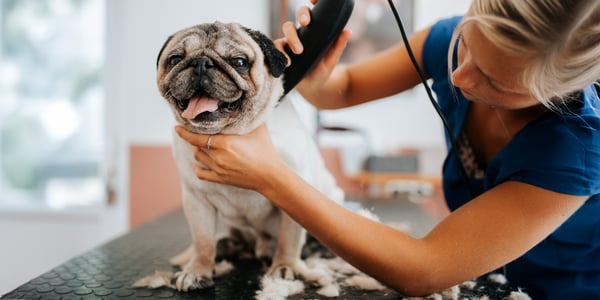


Grooming like a pro
To keep your Pug in good shape, remember to brush that fur every few days. A rubber curry brush or a soft bristle option works well on this short coat.
This removes loose hairs and reduces how much hair lands on your carpets. It also stimulates the skin’s natural oils, aiding a healthier shine.
If you’d like more tips, check out our simple steps on how to groom your Pug.
You’ll pick up a pro routine in no time, and it could help reduce the tumbleweeds floating around your living room.
Try not to go too fast or press too firmly. Keep these grooming sessions positive with treats and praise. You’ll have your dog jumping for joy when they see that brush coming.
Quick tip: You can also use a furminator to help with grooming the undercoat.
Bath time tips for less loose hair
Frequent baths can irritate and dry out a Pug’s coat if you overdo it. You don’t want weekly scrubs, unless recommended by your vet for specific reasons.
Many owners bathe their pets around once every month or two. Use a gentle shampoo made for sensitive canine skin to guard against dryness.
Try a conditioner designed for short-haired dogs to encourage a coat that clings to its hairs rather than flinging them onto your sofa. This is one more way to groom smartly and shed less.
Feeding for a healthy skin and coat
Diet is crucial if you want to help reduce shedding. When you feed high-quality dog food with balanced fatty acids, vitamins, and proteins, your Pug is more likely to maintain healthy skin and a robust top layer of hair.
Remember, a cheap brand loaded with fillers could weaken the hair follicles.
Many Pug owners in the UK choose fresh or wet dog foods that avoid common allergens. We suggest checking out our best wet dog foods guide if you’re looking for quality options.
When in doubt, stick to reputable brands or consult your vet for suggestions on brands that specifically target coat health.
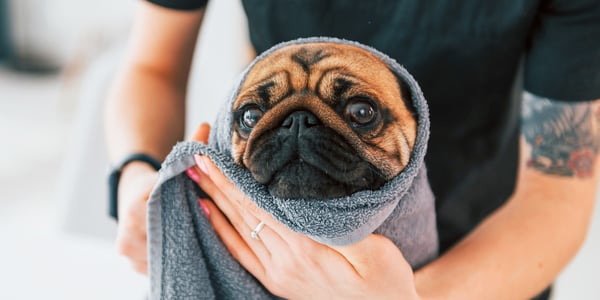


Supplements that can help
Some owners notice a difference when adding omega-3 fish oil or biotin to their dog's schedule. These nutrients support healthy skin and a stronger coat, helping the dog to shed less.
That said, it’s wise to talk to your vet before introducing anything new, as too much of one supplement might not help.
Fatty acids, along with well-rounded diets, work best when combined with a consistent 'bath and groom ' routine.
If you’re unsure whether you should start a supplement, get some trusted medical input.
Keeping allergies, fleas, and ticks at bay
External parasites like fleas and ticks can make your dog itch and scratch, causing hair loss or even a patchy coat.
Seasonal allergies in Pugs can look similar, leading to sores, constant grooming, or skin breaks. That is bad news for your vacuum cleaner.
Prevention is your friend here. Speak with your vet about the best flea, tick, and mite control for your Pug.
Keep those pests away so your dog won’t over-scratch. If you suspect allergies, chat to your clinic about testing or medication to calm the itching.
Final thoughts on managing Pug shedding
Let’s face it, the Pug’s cuddly warmth and wrinkled charm more than make up for stray hairs. Their signature snort is enough to melt any heart, even when you’re picking fur off your trousers.
In most cases, all they need is routine grooming, a thoughtful diet with fatty acids, and prompt vet visits if something seems off.
Like all beloved pets, Pugs rely on us to ensure that their coats remain healthy. A happy, well-cared-for Pug doesn’t just shed less; they shine in every sense.
For even more tips on a Pug’s personality traits or social quirks, check out this post on Pug dog breed temperament.
With a little knowledge, plus a lot of love and humour, you can handle your Pug’s hair like a champ. Enjoy those snuggles, even if they come with a bit of extra lint-rolling.
Waggel Pet Insurance
Need more help? You're in luck if you're a Waggel Pet Insurance member. Along with our excellent coverage, we offer access to a 24/7 online vet to answer all your sticky questions, especially if you need grooming assistance.
Not a member? Why not get a quote now and cover your furry friend for a range of illnesses, all while enjoying our amazing perks and rewards.
Want more like this?
Get updates from us with helpful info, advice, answers to frequently asked questions and much more.
Index:
- Introduction
- Quick answer: Yes, and here’s why
- The science behind Pug shedding
- Common causes of heavy shedding in Pugs
- Spotting the signs of excessive shedding
- Proven ways to keep Pug shedding under control
- Grooming like a pro
- Bath time tips for less loose hair
- Feeding for a healthy skin and coat
- Supplements that can help
- Keeping allergies, fleas, and ticks at bay
- Final thoughts on managing Pug shedding
Related posts:
Get your quote
Along with our excellent coverage, we offer access to a 24/7 online vet to answer all your sticky questions.

